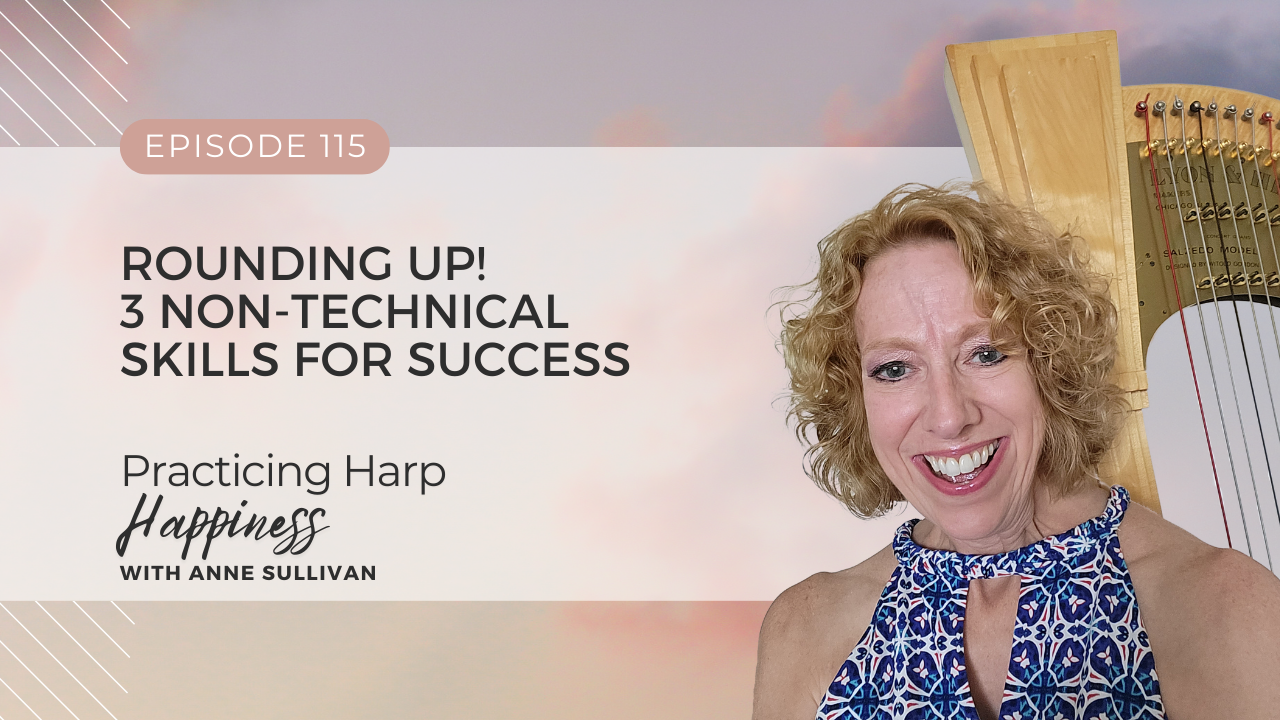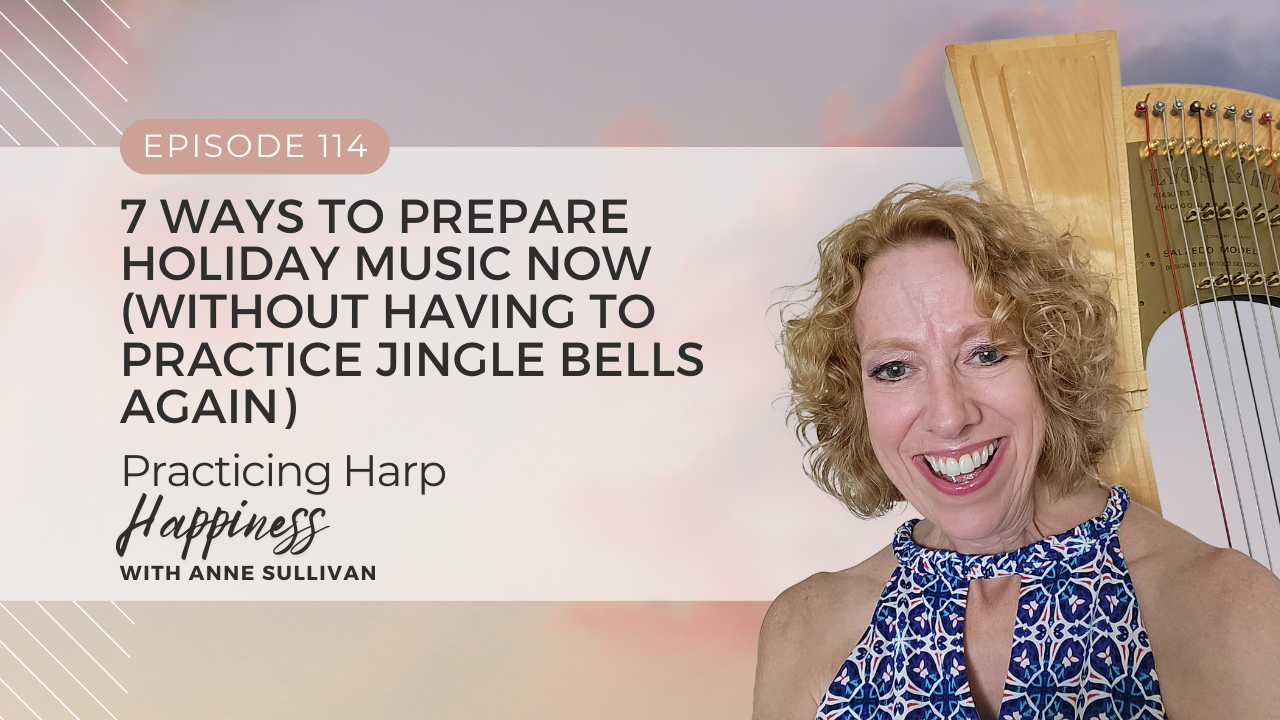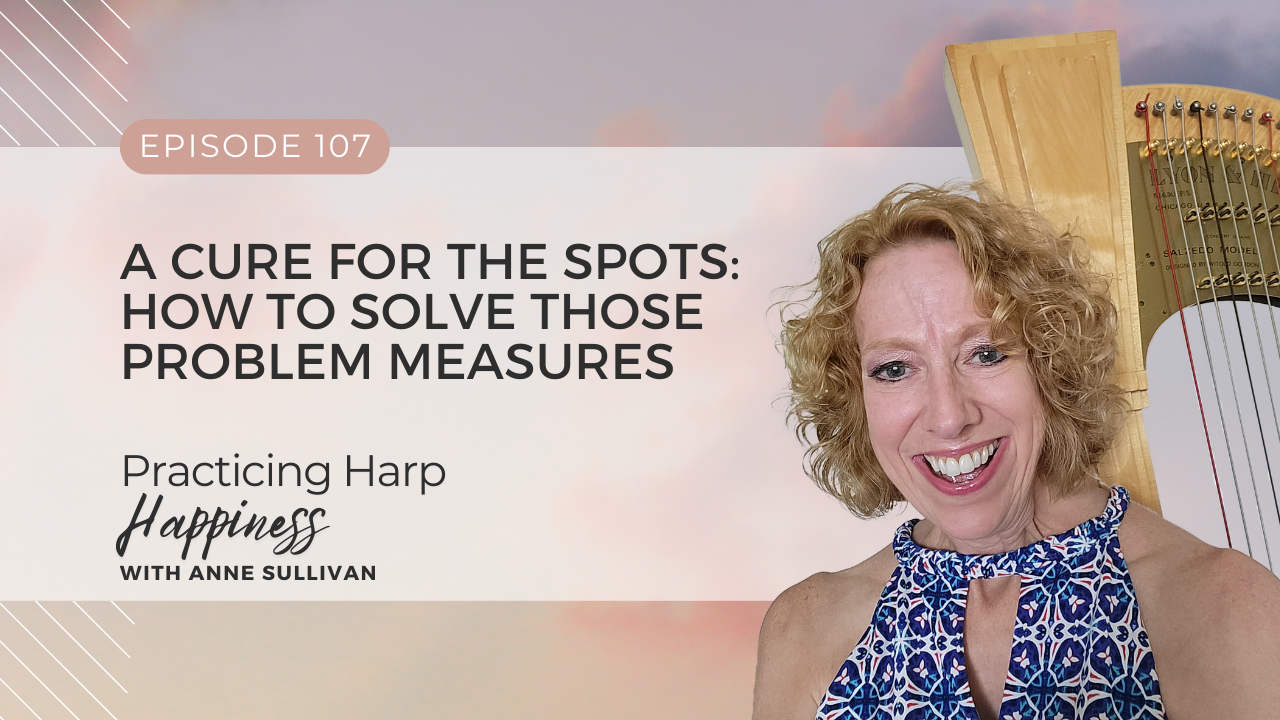Practicing Harp Happiness
#116: Taking the Mystery Out Of Mastery

I once had someone suggest to me that Harp Mastery® was a little ambitious as a name. Was I intending that my blog and my website would only help people at the highest level or help them to become masters of the instrument? Or was I proclaiming myself a “master” of the harp? Eek, definitely not. In response, I told her I believed that mastery didn’t have to be defined as the ultimate level of achievement, although that is how we often think of it. I had a different idea of mastery in mind.
Certainly the term can be applied to the virtuoso whose skill and artistry are, or are destined to become, legendary.
But I believe that all of us harpists, at whatever level of accomplishment, can attain the feeling of mastery, a feeling that encompasses confidence in our ability at our skill level, pride in our achievements and pleasure in our playing. Is that true mastery as we would apply the word to harp legends like Renié, Hasselmans or O’Carolan? Possibly not, although I feel certain th...
#115: Rounding Up! 3 Non-Technical Skills For Success

Today’s show is a special one. It’s a peek inside our My Harp Mastery membership. You’ll be hearing part of a recording of one of our Monday calls. On this call, our topic was three skills that are vital for your harp playing success, in particular memorizing, practicing for flow and continuity, and sharing music with friends. These skills may not sound very exciting, but I really want to share this call with you because I talk about ways to look at your harp playing that may be very different from the way you usually think about your practice and playing. It was an eyeopener for some of our My Harp Mastery members, and I hope it will inspire you as well.
Because this is a recording of a call, you’ll hear me reference some materials that our members have access to but which I can’t share with you here on the podcast. Also, I am talking about these three skills in relation to one of our My Harp Mastery resources, the Scale of Success. This is a curriculum that we offer inside the My...
#114: 7 Ways to Prepare Holiday Music Now (Without Having to Practice Jingle Bells Again)

Christmas in July has become “a thing.”
The official story is that Christmas in July was first celebrated at a summer camp in Brevard, North Carolina in 1933. Being a classic film fan, I knew that Christmas in July was already popular by 1940, due to the film with that title. But now July is nearly as popular for Christmas as December and I’m beginning to think that we will soon see stores moving their Christmas sales from August into July.
Of course, for us harpists, summer is a great time to pull out that Christmas repertoire. In the slower days of summer, we can dedicate some practice time to refreshing and renewing our holiday hits list.
But you don’t have to immerse yourself in “Winter Wonderland” and “Jingle Bells’" or even “Silent Night” to put a little Christmas into your summer. If you’re the type who loves holiday music, then by all means dive in with extra mistletoe and holly. But if you’re not ready to surrender your summer harp playing to ”Away in a Manger” for e...
#113: Three Easy Ways To Get Your Hands Playing Together

There are markers along the road in every harpist’s development, signposts that indicate you’re making progress. These are like those highway signs that tell you how many miles you are from the next town or city, like “New York City - 90 miles.” No matter how long it’s taken you to get to that point and regardless of the traffic jam ahead of you on the New Jersey Turnpike, New York City is now only 90 miles away.
Graduating from three-note chords to four-note chords is one of those markers I talk about often. Another one is fluent hands together playing.
Fluent may not be the best word to describe my meaning. It’s more a comfort level, the point at which hands together playing is not any more difficult for you than playing hands separately. Many harpists develop fluency playing hands separately and then are frustrated when that fluency doesn’t translate to their hands together playing. What they don’t realize is that the processing of information that is required for hands separa...
#112: Video Confident: Empowering Tips for Frustration-Free Video Creation

If you’re finally ready to think about making videos of yourself playing the harp, all I can say is, “Welcome to the party!”
You may have been one of the reluctant ones, thinking the technology was going to be too daunting. Or maybe your barrier to entry has been the fact that you just weren’t ready - until now, that is - to share your music on the wild wide-open worldwide web.
Possibly you were one of those who found the idea of making videos intriguing, but when it came down to actually doing it, you found the process surprisingly difficult.
What I'd like to do in this podcast episode is to help you through the challenges of making videos of yourself. While I’ll touch on a couple of tech-related topics, our focus today is really going to be you, what you need to do to prepare you and your music for making a video or even just an audio recording.
I’ve made numerous CDs and obviously I do a lot of video too, and I learned mostly the hard way what works: how prepared you need t...
#111: The Ultimate Time Machine: Harness The Power Of Your Metronome

Okay, here’s my question for you today. What would be the scariest words you could hear in your lesson? I can think of lots of possibilities but I’m guessing that one of those phrases that comes to your mind might be, “I think we need to get out the metronome.”
If that’s a phrase that makes you start to squirm on your harp bench, you’re not alone. Learning to use the metronome is one of those things that we teachers often fail to teach our students. Sure, we pull out the metronome in lessons and tell our students to practice with it at home, but we don’t often really show them how to work with it or when to use it and why. We almost turn it into a punishment. I sometimes worry I sound like the Wicked Witch of the West; “Well, my pretty, you counted that badly. It’s time for the metronome for you and the little dog too!”
But the metronome is for more than just identifying and solving counting errors or uneven beats. And it’s not just for pushing the tempo faster and faster. Used cr...
#110: Play Your Way to Progress: How NOT to Practice This Summer

What are your plans for your harp playing this summer?
Do you have pieces you want to learn, maybe Christmas music you want to get a head start on? Do you have a few exercise or etude books that you plan to get through so your fingers will finally do what you want? Are you thinking summer is a great time to learn your key signatures or chords or improve your note reading or learn to improvise? Or maybe all of the above?
If your summer harp list looks anything like this, let me hear you say, “Amen.”
Most of us start out the summer with big plans, and not just for our harp playing. We have this imaginary idea that summer is endless and less busy and we’ll have time to get to all those things we can’t manage in the other three seasons. That’s a classic example of wishful thinking. Life doesn’t really slow down just because the days are longer and warmer. What usually does slow down is our drive to achieve, and that’s actually a healthy thing.
Continually pushing ourselves to achie...
#109: Why Other Musicians Study Bach And Why Harpists Should Too

Yes, this episode is about Bach, the Bach, Johann Sebastian Bach. I know some of you are thinking this is a waste of a podcast episode, that you are never going to play any music by Bach and since he didn’t write any music for harp anyway, this couldn’t possibly be relevant to your harp playing.
Let me tell you, you couldn’t be more wrong.
Bach may not have written anything for harp, but his influence is felt by every composer and musician since his time. You probably know that French composer Charles Gounod wrote his beautiful Ave Maria melody as a vocal addition to Bach’s Prelude in C. But perhaps you didn’t know that the trumpet solo on the Beatles song “Penny Lane” came about after Paul McCartney heard trumpeter Dave Mason performing the Brandenburg Concerto No. 2, the same concerto which is featured in the movie The Island of Doctor Moreau. Other movies featuring the music of Bach range from Disney’s Fantasia to the Godfather to Master and Commander and Boogie Nights.
But Ba...
#108: Quick Fix: Buzz No More

Legendary harpist and composer Carlos Salzedo had this to say about buzzing: “It is important that there be no buzzing when replacing. Buzzing comes from lack of precision in replacing, and will be eliminated if the player replaces very accurately.”
That quote comes from the Method for the Harp book that he wrote with Lucile Lawrence, his former student and at the time that method book was written, his wife.
What is interesting about that quote is that even though Salzedo had so much to say about so many aspects of harp playing, that is all he says about buzzing, nothing more.
On the one hand, it’s enough. Every harpist should be replacing accurately in order to avoid buzzing. But we knew that much. What Salzedo leaves us wondering is exactly how we should practice accurate replacing so we don’t buzz. Unfortunately, Salzedo either thought it was too obvious to elaborate on or he wanted to keep his secrets for his students.
I imagine he thought it was obvious, but since it isn’t...
#107: A Cure For The Spots: How To Solve Those Problem Measures

If there’s one thing you could say with certainty that all we harpists want, it’s being able to play the piece we’re working on. That’s why we started the harp, so we could play beautiful music on a beautiful instrument beautifully. But we all know the struggle it takes to make that happen. And we all know the frustration of persisting through the struggle and feeling defeated because there are two measures smack in the middle of the piece that just won’t work.
Call them what you will: problem spots, tricky spots, twisty measures, awkward passages, or maybe names that involve four-letter words. These spots are like a teenager’s pimples. They appear at the worst times and no matter what you do, you can’t really cover them up. They seem to last forever. And the more you mess with them the worse, the worse they get.
Fortunately, pimples do eventually go away. But problem measures won’t necessarily. I know that doesn’t seem like the positive kind of outlook you’re used to hearing from...

